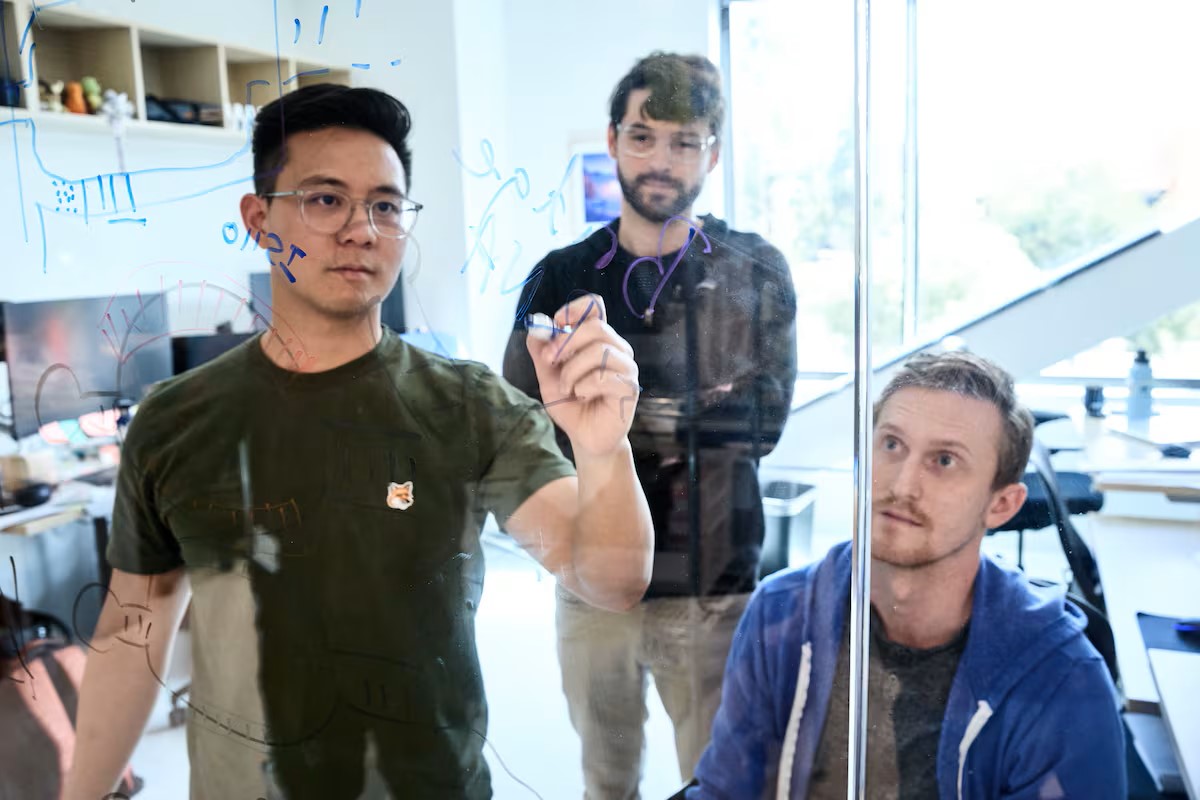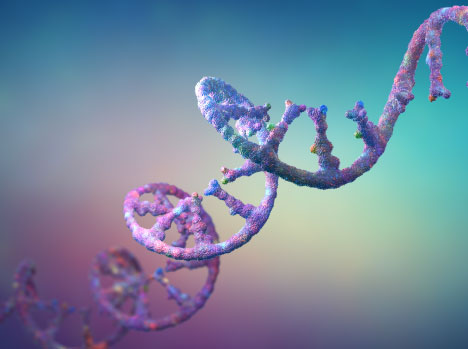
In January, researchers in Hsu’s laboratory (he is also an assistant professor of bioengineering at the University of California, Berkeley) posted a preprint on bioRxiv claiming to have discovered a new class of natural single-effector RNA-guided systems. That story, now peer reviewed, is published online today in *Nature*.
These systems retain the programmability of RNAi and CRISPR while enabling large-scale genome design beyond RNA and DNA cleavage. These modular, bi-specific bridge RNAs can be reprogrammed to enable sequence-specific fundamental DNA rearrangements, potentially accelerating genome design.
“This is a much more complex molecular machine,” Hsu continues. “We’re excited about the potential of this for eventually achieving chromosome-scale genome engineering, with long-range insertions, deletions, and genome translocations.”
Complex Genome Assembly
Hsu, a self-described technologist, creates genome engineering and biological design tools. As a graduate student at Harvard, he worked with his mentor Feng Zhang, PhD, on foundational components of CRISPR as a genome engineering tool. In 2018, Hsu and his team, including Arc Institute co-founder Silvana Konermann, PhD, developed CasRx for efficient targeting of cellular RNA, enabling transcriptome engineering and future therapeutic development.
Hsu sees the greatest challenge today as the manipulation of eukaryotic genomes, particularly large DNA sequences, which limits synthetic biology, cell engineering, and gene therapy. He notes that the modern genome editing method has been stuck on milestones beginning with the initial work of Mario Capecchi, PhD, in 1980 on DNA insertion into mammalian cells, through Martin Evans PhD’s work on chimeric mice, to the genome modifications in mice by Oliver Smithies, PhD, and Capecchi.
Hsu argues that CRISPR-Cas molecular scissors require a complex multistep process with low purity. “You mostly get indels, and only occasionally get the edit, leading to chromosomal translocations and lesions,” said Hsu. He believes that generalizing CRISPR’s success to other cell types or in vivo has been challenging.
Hsu, looking to evolve the genome engineering field, turned to nature for inspiration. For example, during conception, large amounts of recombination and genomic rearrangements from crossover events create unique individuals. Additionally, *Deinococcus radiodurans*, a bacterium extremely resistant to radiation, can reassemble a complete genome after being shattered. He also drew from Barbara McClintock’s work on transposable elements, which showed genetic elements changing positions on a chromosome, causing nearby genes to become active or inactive.
The Bridge RNA Recombinase Mechanism
A few years ago, two members of the Hsu lab, graduate student Nicholas Perry and computational biologist Matt Durrant, PhD, were working on large serine recombinases (LSRs). They sifted through a vast genomic and metagenomic database for mobile genetic elements (MGEs). Investigating IS110s, which had a gene encoding a RuvC-like domain (a key nuclease domain in Cas9), they hypothesized it might encode an RNA-guided transposase system.
Hsu and Durrant’s hypothesis led Perry to search for an RNA as a prerequisite for an RNA-guided transposase system. Their first clue came from secondary structure analysis of IS621, predicted to contain an RNA with a 5′ stem loop and two large internal loops. Meanwhile, Durrant implemented covariation analysis to predict base-pairing interactions between the non-coding RNA (ncRNA) and the target or donor DNA.
“It was a messy initial analysis… but it worked,” said Durrant. He saw signals indicating programmability. The team eventually confirmed the mechanism for a programmable target loop and donor loop, suggesting the RNA acts as a “bridge” between target and donor DNA to enable recombination by the IS621 recombinase. This discovery of a single-effector recombinase system using a bridge RNA with two binding loops, independently programmable to bind and recombine diverse DNA sequences, was unprecedented.
A GUI for Genome Engineering
Hsu likens these bridge RNAs to a graphical user interface (GUI) for genome design, making the process more intuitive and efficient. He believes nature has more programmable systems to discover, and he will continue exploring biotechnology’s potential.
Image: Researchers Patrick Hsu, Nick Perry and Matt Durrant, from the Arc Institute, in Palo Alto. By RAY RUDOLPH

Check out our mRNA service to expedite your vaccine research
PackGene Biotech is a world-leading CRO and CDMO, excelling in AAV vectors, mRNA, plasmid DNA, and lentiviral vector solutions. Our comprehensive offerings span from vector design and construction to AAV, lentivirus, and mRNA services. With a sharp focus on early-stage drug discovery, preclinical development, and cell and gene therapy trials, we deliver cost-effective, dependable, and scalable production solutions. Leveraging our groundbreaking π-alpha 293 AAV high-yield platform, we amplify AAV production by up to 10-fold, yielding up to 1e+17vg per batch to meet diverse commercial and clinical project needs. Moreover, our tailored mRNA and LNP products and services cater to every stage of drug and vaccine development, from research to GMP production, providing a seamless, end-to-end solution.
Related News
Cartesian Therapeutics Secures $130M in PIPE Financing for Pioneering mRNA Cell Therapy
Cartesian Therapeutics, Inc. (NASDAQ: RNAC), a clinical-stage biotechnology company known for its innovative mRNA cell therapies targeting autoimmune diseases, announced today a significant milestone in its financial journey. The company has entered into a securities...
When the Wegovy stops, the weight gain restarts. Could a GLP-1 gene therapy change that?
GLP-1 drugs like Eli Lilly's Zepbound and Novo Nordisk's Wegovy work to address obesity—as long as a patient keeps taking them. Harith Rajagopalan, M.D., Ph.D. thinks his company, Fractyl Health, may have the answer: a gene therapy that integrates a GLP-1-secreting...
REGENXBIO Announces Expansion of AFFINITY DUCHENNE® Trial to Include a New Cohort of Younger Patients
Company to begin enrollment of patients aged 1-3 years Expects data from younger cohort to be part of pivotal plans and BLA filing for broad label End-of-Phase II meeting with FDA scheduled for late July to finalize pivotal program design Based on recent commercial...
Top 10 Companies Dominating the Global Drug Delivery Systems Market
"Revolutionizing Healthcare Horizons: Delving Deep into Advanced Drug Delivery Systems (ADDS) and Forecasting an Explosive $359.1 Billion Market Growth by 2028, BCC Research Study" Demand for effective solutions has never been so urgent to prevent global chronic...
Related Services

Plasmids GMP Services

AAV GMP Services


